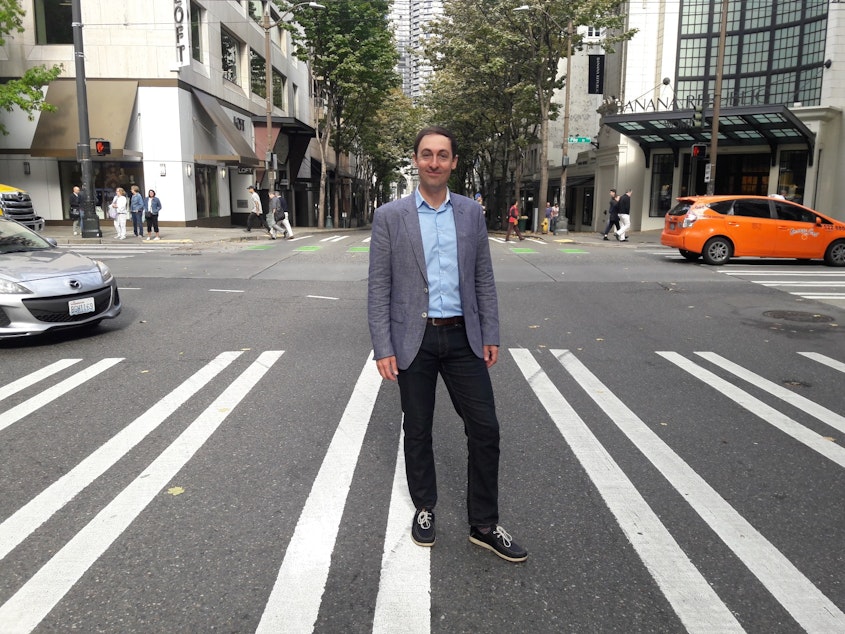Can measuring 'happiness' on your commute help streamline transit?

Seattle has done a better than average job of getting people out of cars and onto public transit. But 31 percent of commuters still drive alone. In terms of comfort, it's no wonder: On the bus, sometimes you can’t even get a seat.
In Victoria B.C., officials are trying to change that equation. They want to make bus rides as comfortable and convenient as car rides.
Dallas Gislason is an official with South Vancouver’s economic development authority. He said his organization is taking a data-driven approach to making bus rides better.
Here are three big ideas he says will roll out in Victoria, Canada next summer.
1. Put all commute options in a single app, so you can truly understand commutes.
This two-part idea begins when transit authorities negotiate data sharing agreements with rideshare companies and bikeshare companies, so that their services may also be accessed through a single transit app.
Compare that to the current experience, which requires users to juggle multiple apps to compare transportation modes. Woe to suburban riders who must cobble together multiple apps and need additional options to travel the last mile from the park and ride to their home.
King County is working on integrating modes into a single app. But South Vancouver plans to go further by using the app (along with other methods) to collect user ratings for different parts of a journey.
Was your Uber ride to the park and ride great, but the bus you caught from there uncomfortable and overcrowded? Did your bus drop you off blocks from your work — but when you walked in the rain on narrow sidewalks the rest of the way, a passing truck splashed through a huge puddle and soaked you?
That’s actionable information that can guide government responses. Maybe the key to getting you on the bus more consistently is fixing a clogged gutter or widening a sidewalk.
2. Use artificial intelligence to predict bus problems.
Gislason knows a lot of commuters who avoid buses for their apparent failure to anticipate demand. “The bus is completely full, and you’ve got to hang on to the little rod in the middle and you bounce around and you bang against the person beside you,” he said.
In the Seattle area, Metro buses come with a button that bus drivers can hit to alert headquarters that their bus is too full. Passenger counters help Metro planners understand the data further. Then, humans decide where to put extra buses, sometimes even inserting them in the middle of a route, said Metro spokesperson Jeff Switzer.
But for all Metro's well-meaning planners, Victoria hopes to achieve better results by outsourcing some of those decisions to computer algorithms, which Gislason said can discover nuanced patterns and recommend solutions before they're needed.
For example, when it rains hard on a Thursday morning, the 8:05 and 8:11 a.m. buses on a particular route may become far too crowded, resulting in a surge of poor user ratings for that leg of the trip. The transit authority's algorithm might predict a problem in advance and recommend reducing the time between a handful of buses (the “headways”) from six minutes to five minutes, when those particular conditions arise.
“And that would then lead to — 'Hey, I get on the bus, there’s a seat for me, I can sit there and I can read my book on the way to work,'” said Gislason. “That’s an enjoyable experience.”
3. Let commuter happiness guide all decisions.
Gislason said many cities seem to be driven more by technology companies' sales pitches than by citizen needs. IBM, Qualcom, Microsoft and Google play videos showing intersections where cars, buses and pedestrians smoothly flow past each other.
Gislason summed up the sales pitch they give: "They say 'We can come in and we can deploy all these sensors and technologies and make your city run like a Swiss clock."
But the promotional videos seldom reveal the shortcomings of any given technology. For example, Gislason said you can spend money on bringing smart technology to a limited number of intersections - only to see the problems you intended to solve ripple out to neighborhoods beyond the investment zone.
Instead, Gislason said, starting in 2019, South Vancouver's transit agency plans to use human happiness as a guide to all investment decisions. He said the region's planned "Mobility Wellness Index" could be the first of its kind in the country.
Already, examining commuter happiness has shown results. That's how South Vancouver decided to focus so much attention on relieving crowded buses. "In survey after survey, they ask people about their life satisfaction," said Gislason. "And riding in a personal automobile is actually the lowest in satisfaction — except for riding in a crowded bus."
In the future, the Mobility Wellness Index will help the transit agency decide whether strategies such as investing in protected bike lanes or adding more buses work. A successful strategy should increase human happiness in and around the neighborhood where it's deployed.
Victoria is just one of many Canadian cities looking for ways to harvest data so their cities can become more livable. The frenzy of Canadian ideas on this topic is being driven by their federal government, which offers a 50 million dollar prize to the most creative city, and 10 million dollar prizes for smaller cities like Victoria.




